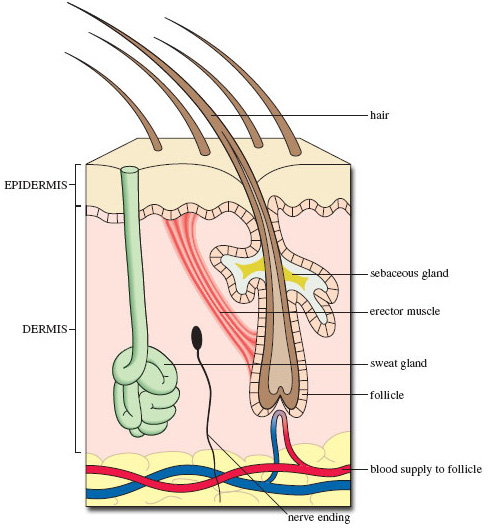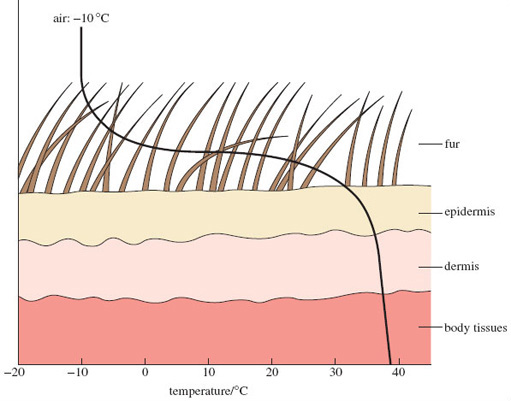6 Thermoregulation and mammalian fur
A coat of profuse mammalian body hair is commonly called fur. Fur provides insulation, which is a property that one first thinks of as useful for mammals to help retain body heat. Fur is a unique and fundamental feature of mammals, though not all living species possess it.
Question 12
From your general knowledge, what characteristic is shared by those tropical mammals that have little or no fur?
Answer
In general, they are very large animals - think of the rhinoceros and the elephant. Large animals have the advantage of warming up comparatively slowly in hot conditions, so delaying dangerous rises in body temperature. But for the same reason, they often have severe problems when they need to lose heat. So, for very large tropical animals the loss of fur is likely to have conferred a significant advantage.

Figure 4 is a cross-section through the skin of a mammal, including a slice through a single hair. Its root is embedded deep within the inner layer of the skin, called the dermis. The sebaceous gland provides the oily secretion that helps keep the fur in good condition, while the contraction of the erector muscle makes the hair stand up; their combined action 'fluffs up' the fur, increasing its powers of insulation. In passing, note the sweat gland that is located deep within the dermis and the blood vessels that supply the base of the hair with nutrients. This point is where cell division and growth of the hair occur and the newly formed hair shaft (rich in keratin, see Section 4) pushes upwards. The part of the skin that is visible is the overlying epidermis, which is composed of cells (now dead) that were initially produced by cell division within a growing area deep within the dermis. You'll appreciate that Figure 4 is a generalised view - different mammals show particular characteristics of skin structure. For example, the skin of the echidna would look very different from that shown in Figure 4, with a mix of 'normal' coarse hair - the length of which varies according to location and therefore climate - and large single 'hairs', mentioned earlier [p. 15], which are so well reinforced with keratin that they more closely resemble our own nails in hardness and chemical make-up.
The insulation provided by fur comes not from the hair itself, but largely from the layer of air trapped within the fur. Air is a very effective insulator, which is the same as saying it's a poor conductor, i.e. it has a very limited ability to convey heat away from a warm surface, such as the epidermis. Calculations reveal that if a layer of still air of about five centimetres (i.e. 5 cm) could be held in place close to the skin, it would provide the same level of insulation as would the impressively dense winter coat of the arctic fox.

Figure 5 is a plot of the temperatures at sites within and beyond the skin surface when a well-insulated polar mammal (a wolf or an arctic fox) is exposed to an air temperature of −10 °C. Near the tips of the fur, the temperature is −10 °C but the surface of the epidermis is close to 30 °C. So a temperature difference (or gradient) of about 40 °C can be supported at either end of the 6-cm-thick fur layer, due to the excellent insulating properties of the air contained within the long, fine and densely packed fur. You can see just how little insulation is offered by the epidermis and dermis; however, the picture is different in the polar bear, which has coarse outer hair and dense underhair and relies for insulation more on blubber underlying the skin - an arrangement better suited to its amphibious existence.
You'll appreciate by now that mammals that show a very small increase in metabolic rate as outside temperatures fall (see Figure 3) do so largely because of very effective insulation. Conductance is the name given to the flow of heat from one material to another, say from the skin to the outside air. An effective coat of fur ensures a very low level of conductance of heat; the more flimsy coat of a tropical animal provides a higher conductance. So, the slope of the lines in Figure 3 is a measure of conductance - the steeper the slope, the greater the conductance.
As LoM and the TV programme have suggested, the combination of endothermy and the ability to conserve the large amounts of body heat generated has contributed enormously to the success of mammals. What is remarkable is that fur has proved sufficiently versatile during the evolution of mammals to make physiological sense for the amphibious platypus, the cold-adapted arctic fox and the sun-baked red kangaroo alike.
